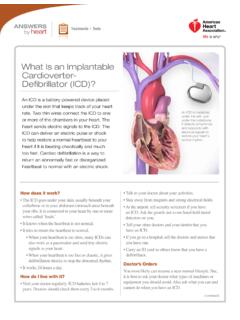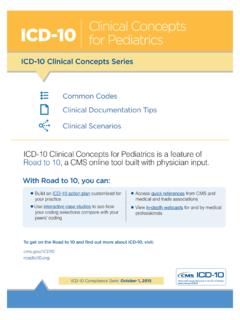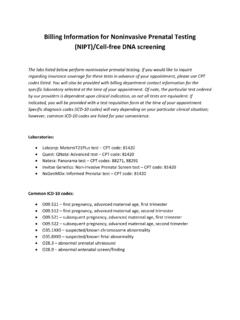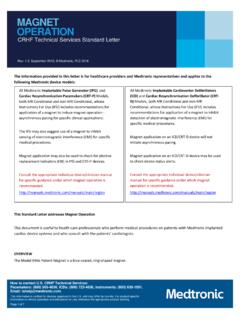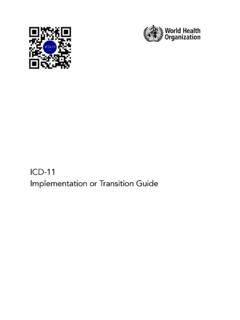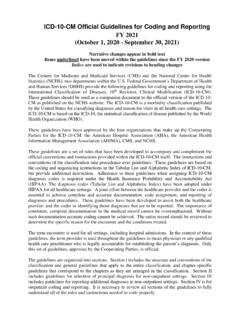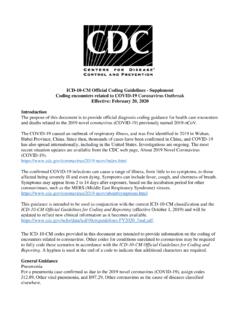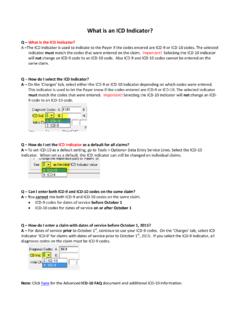Transcription of Your Medical Documentation Matters - CMS
1 your Medical Documentation Matters2 IntroductionThis is the case study used during the your Medical Documentation Matters presentation. It is a tool used for reviewing the details of the case during the presentation and the Documentation requirements for the various provider types furnishing services. It highlights important Federal and State Medicaid Documentation regulations and rules. To illustrate these points, the case study follows a patient s course of treatment through several Medical services and the respective provider types furnishing the services. The case study begins with the patient s emergency transport and ends with his discharge from is a unique program and is quite different from Medicare. Medicare has nationwide laws and standards that every provider in every State must follow.
2 Medicaid programs and regulations, on the other hand, vary by State. In addition, each State has the option of developing and implementing Medicaid waiver programs. Waiver program rules can also vary from State to State and even within the same State s of the general information for one provider type is the same as other provider types. As providers, you should be familiar with the nuances of the Medicaid program in the States where you furnish services. It is the provider s responsibility to know and follow all Medicaid rules in the States where they practice. If there are any questions regarding Documentation , contact your State Medicaid agency (SMA). Visit that State s Medicaid website for contact information or look it up at [1] on the s meet our Medical Documentation MattersCase is a 52-year-old male patient.
3 He is 6 feet tall and weighs 265 pounds. currently smokes 1 pack of nonfiltered cigarettes per day and drinks approximately 1 case of beer per week. He was diagnosed with hypertension, high cholesterol, and Type 2 diabetes at age 40. His home medications include lisinopril, simvastatin, glipizide, and metformin. His blood pressure, cholesterol, and diabetes were well-controlled until about 2 years is married, and he and his wife have three children under age 17. He worked as a computer programmer for a small corporation for 18 years. The corporation went out of business 2 1/2 years ago. Since then, he has been working part time for a local retailer while he continues searching for full-time permanent employment in his field. His wife has been working at their church as a part-time secretary for 20 years.
4 And his wife are ineligible for health insurance benefits through their employers. Over the past 2 1/2 years, their standard of living has decreased, and they have depleted their savings. The entire family receives Medical services through the State s Medicaid struggles daily with his feelings of anger, hopelessness, and worthlessness. He is more withdrawn, finds little joy in life, and he refuses to engage in family activities, even though he used to initiate them. His agitation is growing, and his family members avoid TransportIt was a typical Friday evening. s family members were out, and he was home alone. When he attempted to get up from his recliner, he found he could not stand or walk due to severe right leg pain. was unable to reach anyone in his family by phone. After about an hour of continually trying to reach one of them, he called 911 and an ambulance was sent to his home.
5 During transport to the hospital, the emergency Medical technician (EMT) took a brief history from him and documented the information. The brief history included s chief complaint ( ), his vital signs, his current medications, and the Medical need for the ambulance transport. Upon arrival at the hospital, the EMT verbally reported the information to the nurse on Department PhysicianThe emergency department (ED) physician evaluated His history and physical revealed blood glucose of 260 milligrams per deciliter (260 mg/dL), and a foot ulcer of approximately 2 centimeters in diameter with surrounding necrotic tissue extending 2 centimeters from the edge on the bottom of his right foot. The rest of his foot was red and warm to the touch. The redness and warmth extended up his leg to approximately 6 inches below the knee.
6 He had no sensation in his foot with the pinprick test, and he lacked ankle reflexes. His white blood cell count (WBC) was 22,000 cells per cubic millimeter. showed signs of sepsis, so the ED physician ordered a lactate level. The nurse in the ED took s vitals every 15 minutes to track the hypotension. The lactate test came back Admits to Intensive Care UnitThe ED physician contacted the hospitalist immediately. The hospitalist admitted to the intensive care unit (ICU). Once was admitted to the ICU, the hospitalist started him on piperacillin/tazobactam and vancomycin, fluid resuscitation, and ordered an X-ray of his right leg. The X-ray showed clear osteomyelitis. The hospitalist documented wound drainage, purulence, fluctuance, odor, length of time the ulcer had been present, and that had not received any wound care prior to hospitalist immediately consulted with an orthopedic Surgeon Consult NotesUsing the hospital s electronic health records (EHRs), the surgeon documented the consult report after examining The consult report reads as follows:Day of Consult (10/30/15): Code : Swollen painful right foot and legHPI: is a 52 y/o male with known Type 2 diabetes mellitus x 12 years that was brought to the ED by ambulance with acute onset of severe pain and inability to stand or bear weight on the leg.
7 His vital signs showed a temperature of (T ), blood pressure of 90 over 45 (BP 90/45), heart rate of 95 beats per minute (HR 95 beats/min), and a respiration rate of 20 beats per minute (RR of 20 breaths/min). He was admitted by Hospital Medicine service and started on piperacillin/tazobactam and vancomycin. He was noted to have an ulcer on the bottom of the foot. He notes the ulcer has been present for about 2 months and has not changed in size. He has noted no drainage or odor until the last 3 days when it has begun draining pus and had a horrible smell. He treated it with Epsom salts and Neosporin. His foot and leg have become more swollen over the last 48 hours, and he has experienced low-grade fever, chills, and nausea, as well as progressively increasing pain. His foot is numb and has been so for about 2 years.
8 History of present illness was extended (HPI: Extended); and his pain is rated as a 10 on a scale of 1 to 10, with 1 being the least and 10 being the most (Pain is 10/10).CPT only copyright 2016 American Medical Association. All rights Medical Documentation MattersPast Medical History (PMH): CompleteMedical Illness: Hypertension (HTN), elevated cholesterol well controlled with medications x 12 yearsSurgery: Tonsils and adenoids (T&A), cholecystectomyMedications: lisinopril, simvastatin, glipizide, metforminAllergies: Penicillin causes a rashSocial Family History (SFH): Maternal grandparents coronary artery disease (CAD), diabetes mellitus (DM) Paternal grandparents: Hypertension (HTN) Mother: Obesity, DM, CAD, myocardial infarction (MI) Sister: Obesity, DM, HTN Brother: MI 45 y/oHabits: Smokes 1 pack per day x 20 years (PPD x 20 yr); drinks 1 case of beer per week.
9 No illegal or street drugs ROS: (Extended)Head, eyes, ears, nose, and throat (HEENT): No visual or hearing problems, but wears reading glassesCardiac: No recent chest pain, palpitations, or shortness of breath (SOB)Respiratory (Resp): No dyspnea, orthopneaGastrointestinal (GI): Positive for recent nausea, no vomiting, diarrhea, or constipationGenitourinary (GU): No dysuria or frequency; urinates two times per night (nocturia x2)Neurologic (Neuro): Bilateral lower extremity (LE) numbness in stocking distribution, no weakness, tremors, or seizuresEndocrine: Diabetes poorly controlled x 2 yearsPhysical Evaluation (PE): (Detailed)General: Alert, and oriented to person, place, and time (Ox3)Head, eyes, ears, nose and throat (HEENT): Pupils equal, round, and reactive to light (PERRL), no palpable lymph nodesHeart: Regular rate and rhythm of the heart (RRR), no murmurLungs: Clear to auscultation and percussionAbdomen (Abd): Soft, non-tender, active bowel sounds (BS); no hepatosplenomegalyNeuro: Decreased light touch sensation in both lower extremities in a stocking distribution to mid-calf.
10 Absent plantar reflex in both ankles6 Skin: Two-by-two centimeter (2x2 cm) ulcer on plantar aspect of the right foot over 2nd metatarsal head with necrotic base. Fluctuance is present to level of the heel. Foot is warm throughout and redness extends to mid-calf. It is tender to palpation. There is purulent drainage from the ulcer with a significant malodor. The leg is red, swollen, and warm to mid-calf. Homan s is negative. Foot and leg are insensate in a stocking distribution to mid-calf. The left foot has abnormal callousities across the metatarsal heads and is insensate in a stocking distribution to the level of the ankle. The skin is intact without areas of breakdown. Dorsalis pedis pulse is (1 plus) 1+ : Glucose 260 mg/dL; WBC 22,000 cells per cubic millimeter with 17 percent bandsX-ray: Anteroposterior (AP), lateral and oblique views of the right foot show bony destruction of the 2nd metatarsal head with gas in the soft tissueMRI: Destruction of the right second metatarsal head with soft tissue fluid extending above the ankle in the posterior compartment; there is edema in the bone of the first and third metatarsalsImpression: 1) Osteomyelitis of the right second metatarsal which may extend to the first and third metatarsal based on the edema on the MRI.










